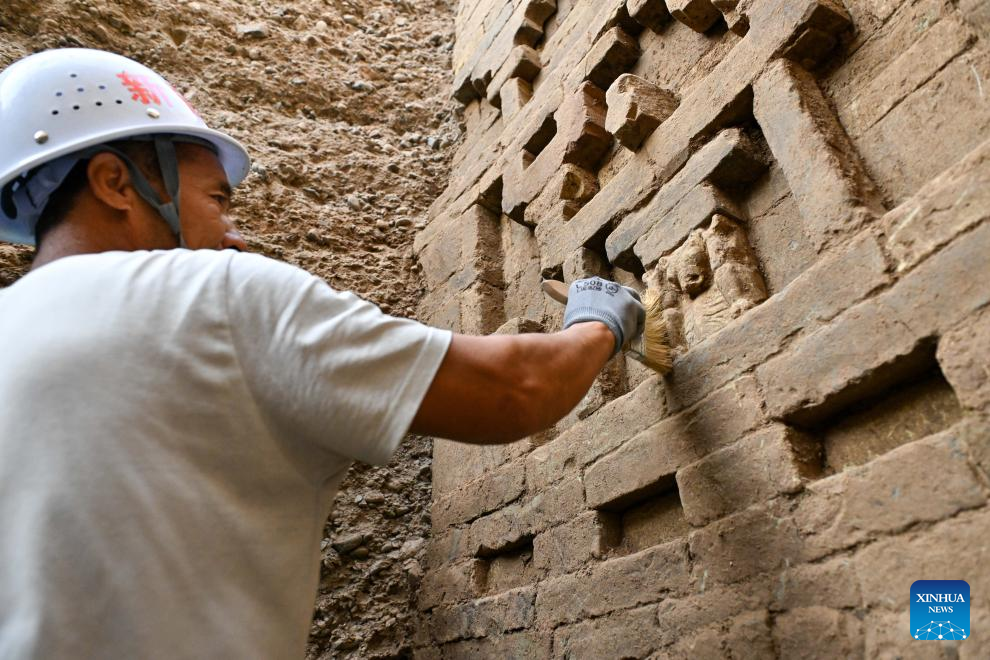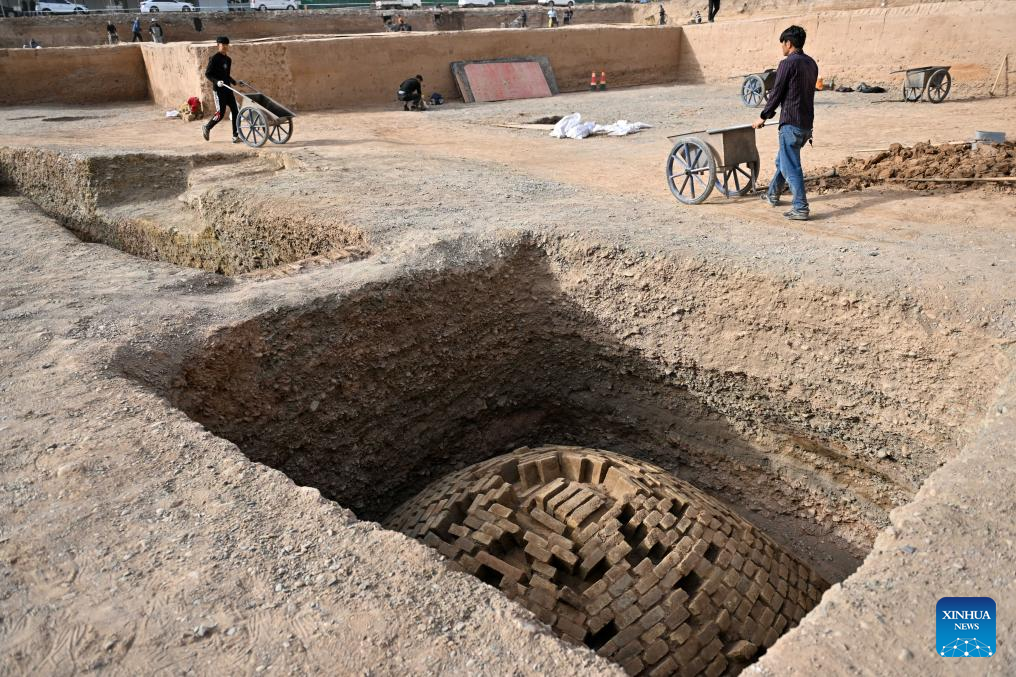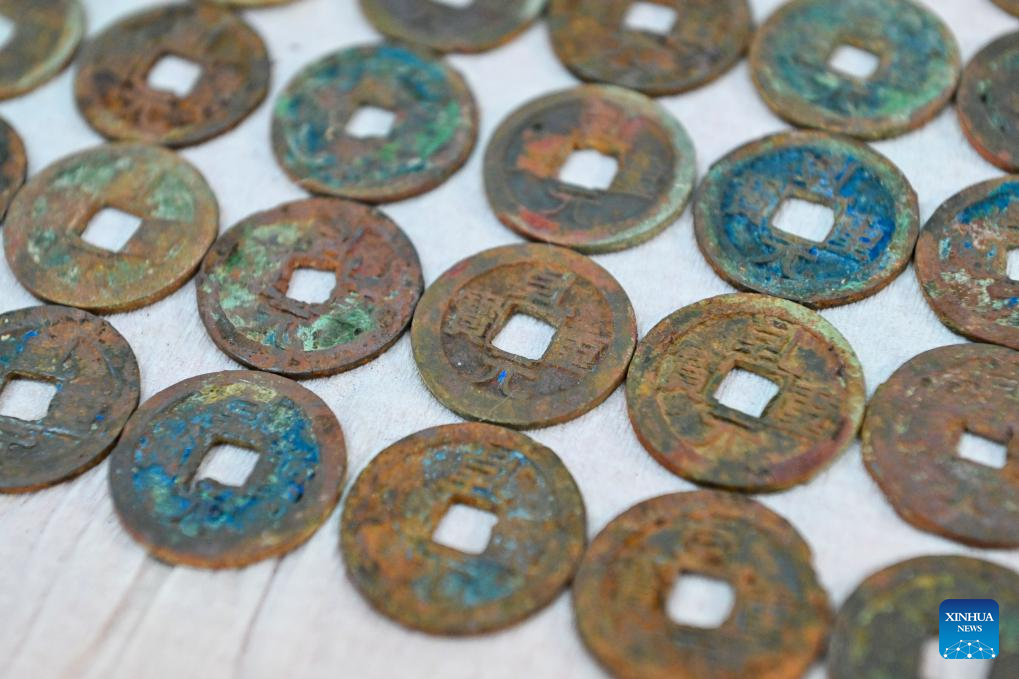Technologies breathe new life into millennia-old treasures
From:XinhuaAuthor: 2025-01-15 16:08

This file photo taken on Oct. 18, 2023 shows an archaeologist working at the excavation site of the Youyi Road cemetery in the city of Kuqa, northwest China's Xinjiang Uygur Autonomous Region. (Xinhua/Ding Lei)
When it comes to archaeology, many people might still think of a shovel and a brush as the go-to tools. But modern archaeology has evolved far beyond that.
According to archaeologist Li Shiwei, nowadays, it's all about buzzing drones hovering in the sky for exploration and archaeological shelters equipped with monitoring and early warning systems.
Around 7,000 to 5,000 years ago, the Yangshao people in today's Henan Province, central China, built settlements on river terraces. They engaged in farming, animal husbandry, hunting and pottery making.
Not long ago, the Henan Provincial Institute of Cultural Heritage and Archaeology reconstructed the appearance of the Yangshao ancestors through a technological analysis of human bones unearthed during the fourth excavation of the Yangshao Village site.
For the first time, these ancestors were vividly presented to the world. Li was in charge of this latest round of excavations, which began in August 2020.
Unlike in the past, they integrated multiple disciplines and used technology to conduct large-scale aerial photography and precise mapping of the site, establishing a three-dimensional coordinate system and a geographic information system, according to Li.
Li added that they utilized the cutting-edge field archaeological excavation management system throughout the excavation process. All archaeological data, including photos and videos, were digitized for permanent preservation and subsequent analysis and research.
"In the past, all unearthed artifacts and information had to be manually drawn and recorded by technicians, piece by piece, which was very inconvenient for marking, archiving and studying," Li recalled.
His team is still conducting ancient DNA research, hoping continuous research will more comprehensively reveal the historical dynamics of prehistoric populations.
In northwest China's Xinjiang Uygur Autonomous Region, molecular biologists have used genomic data to calculate the kinship relationships among more than 200 sets of remains from the Youyi Road cemetery in the city of Kuqa.
Kuqa in Aksu Prefecture was an important transportation hub along the ancient Silk Road. With the help of modern technologies, the researchers are able to clearly identify where the ancient residents of Kuqa came from and how multiple ethnic groups gradually integrated over the time.
This indicates that the Xinjiang region has always been an important area for the interaction, exchange and integration of multiple ethnic groups, said Cui Yinqiu, a professor from the College of Life Sciences at Jilin University.
Advanced technologies make archaeological excavations more precise and efficient and enable permanent preservation and sustainable use of information on cultural relics.
In the city of Luoyang, Henan, stands the Longmen Grottoes, a UNESCO World Heritage site which also represents the pinnacle of Chinese stone carving art. The Longmen Grottoes are over 1,500 years old, with over 2,300 existing niches and over 100,000 stone statues.
In recent years, by using high-definition 3D scanning technology, local researchers have established a high-precision, scientific and comprehensive database, which covers the grottoes, existing cultural relics and those scattered around the world.
"Since 2021, we have applied 3D digital technology to the search, determination of the original position and virtual restoration research and display of scattered cultural relics," said Gao Junping, director of the information and data center of the Longmen Grottoes Research Institute.
So far, three overseas-returning cultural relics and four digitally returned cultural relics have been restored and displayed through 3D printing, according to Gao.

This file photo taken on Oct. 18, 2023 shows the excavation site of the Youyi Road cemetery in the city of Kuqa, northwest China's Xinjiang Uygur Autonomous Region. (Xinhua/Ding Lei)

This file photo taken on Oct. 18, 2023 shows the ancient coins excavated from the Youyi Road cemetery in the city of Kuqa, northwest China's Xinjiang Uygur Autonomous Region. (Xinhua/Ding Lei)
Edit:董麗娜
The copyright of the article and the picture belongs to the original author. If there is any infringement, please contact to delete it